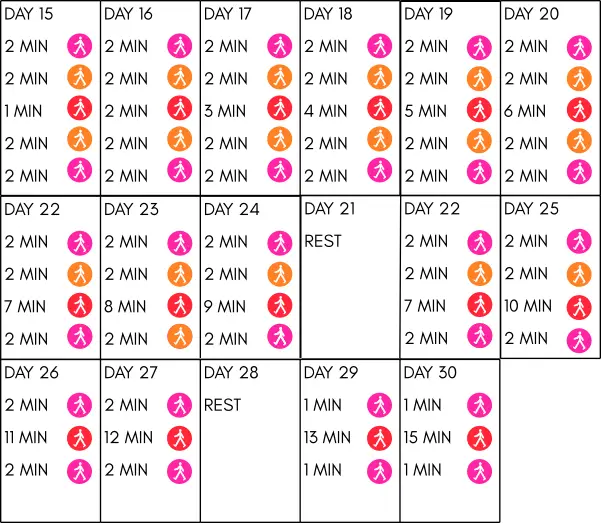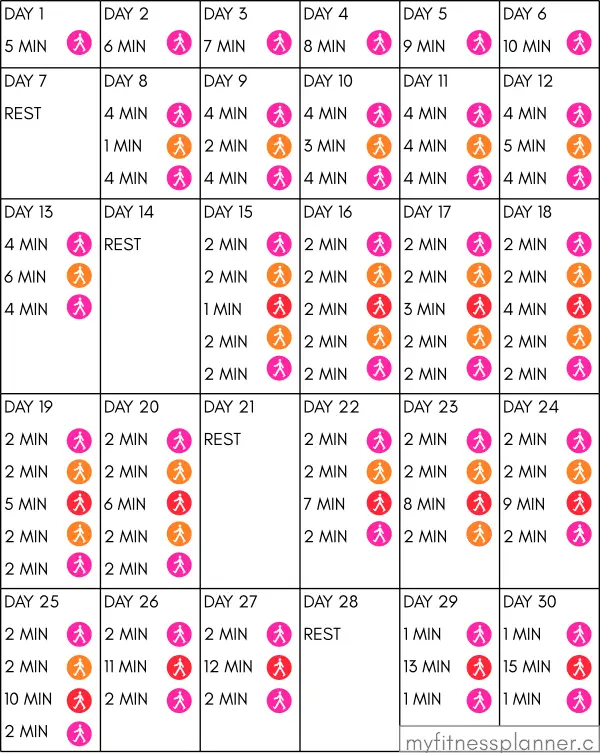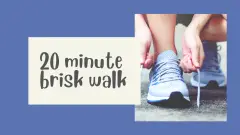This 30 day walking challenge is easy to fit into your every day life and will get you into the habit of regular walking for fitness. It starts off with a 5 minute walk and ends up being a little over 15 minutes.. It uses speed intervals help you gradually build up your walking speed, which will increase the benefits to your cardio health and burn more calories. There are 3 speeds in this program:
- Normal walking pace
- Moderately fast walking – a bit quicker than normal pace. You start to feel like you’re making an effort, but you’re not feeling out of breath.
- Fast walking – this speed makes you feel a bit warmer and your breathing rate increases. Holding a conversation is more difficult at this speed.
30 day walking challenge schedule
The 3 walking speeds are colour coded on the charts in this post and on the printable:
Pink = normal walking speed
Orange = moderately fast walking
Red = fast walking

Days 1-6

This is straightforward walking at normal pace. The walking time increases by one minute each day.
Days 8-13

Following a rest day, on day 8 we introduce some moderate speed walking. Over the next few days, the time at this speed gradually increases.
Days 15-30

After another rest on day 14, the second half of the challenge includes walking at all 3 speeds. For the last few days, level 2 is dropped and the walks consist of a warm up and cool down with a fast walk in between.
Full schedule

Safety and comfort when walking
Although walking is a natural activity that we do every day, fast walking can be strenuous. Please read these general exercise safety notes before you start.
You will probably get quite warm during the faster intervals, so it’s best to wear layers that can be easily removed. Training shoes aren’t necessary, but you should wear flat, comfortable shoes. Walking in heels isn’t good for feet or posture. Also, make sure you’re properly hydrated before you start and you may want to take a water bottle to sip from as you’re walking.
Using a treadmill for the workout
This challenge can be done either by walking outdoors, or on a treadmill. Although it’s good to get outside in the fresh air, you may prefer to do your walking indoors, especially if the weather is bad. Set your treadmill to the average walking speeds for the levels shown below and adjust up or down a little if necessary to suit your own walking speeds.
Pink/normal walking speed: 3mph/5kmh
Orange/moderately fast walking: 3.75mph/6kmh
Red/fast walking: 4.5mph/7kmph
Buying a treadmill for home use
Now that folding treadmills are widely available, having a home treadmill doesn’t mean you need a dedicated workout space. You can fold your treadmill up and store it out of the way between workouts. If you’re thinking of buying a home treadmill, here are some points you should consider:
- Are you likely to run on it? If so, you should avoid very lightweight models. Also, a cushioned running/walking deck will help to absorb impact.
- Dimensions: there’s a slight variation in dimensions between models. If you’re tall, you might prefer a longer walking/running deck to allow for a longer stride. Obviously, the treadmill needs to fit in your chosen storage place when it is folded away.
- What sort of a console do you want? Is it important to you to have a multi-feature console with a choice of pre-set programs, or will you be happy with something simple that just lets you set speed and incline? Extra functions add to the cost of the treadmill, so think about whether you really need them.
- What is the incline range? Some treadmills only have a limited incline range. Models that offer up to 12% give you more options to vary your workouts and to challenge yourself more as your fitness improves.
- Maximum speed – if you run fast, or plan to do sprint intervals, you should bear the maximum speed in mind. For walking, or average speed running, any treadmill will be fine.
See a treadmill buying guide here
Your walking route
If you’re walking outside, you’ll need to plan a route. At average walking speeds for the 3 levels, the distance you cover on day 1 would be around a quarter of a mile (0.4 km). However, it increases over the course of the challenge to 0.7 mile (1.1 km)on the last day. Because the distance changes every day, the simplest way to plan your route is as follows:
- Plan a route of about half a mile (0.8km). This should be more than enough for all the days of the challenge.
- Each day, walk along your route for half the given time, then turn around and walk back.
As you work through the challenge, you’ll get further along your route before it’s time to turn around.
To time the intervals accurately, you can use a fitness watch, phone stopwatch or fitness app, or an ordinary stopwatch.
The health and fitness benefits of walking
#1 Burns calories
The more active you are, the more calories you burn.
#2 Makes your heart stronger
Our hearts adapt to exercise by getting bigger and stronger so that they can pump more blood with each beat.
#3 Improves your circulation
The circulatory system also improves, in order to get the extra blood to the working muscles.
#4 Reduces stress and anxiety
All exercise can be beneficial to mental health, but walking outdoors is particularly beneficial.
#5 Improves mood
As well as reducing stress and anxiety, exercise causes endorphins to be released. These are the “feel good” hormones that make us feel positive, happy and energised.
#6 Strengthens your muscles, ligaments and tendons
When we use our muscles, ligaments and tendons regularly, they adapt and become stronger, in order to make the activity easier.
#7 Improves your flexibility
Lack of movement makes muscles tight. Regular exercise will maintain your muscle length. (If you want to increase flexibility, then you need a stretching routine.)
#8 Improves your balance and coordination
All exercise is good for balance and coordination. If you walk on different surfaces, in different weather conditions and on different gradients, all these factors help to improve balance and coordination. If you’re walking indoors on a treadmill, you obviously won’t experience differences in walking surface or weather. However, you can alter the gradient a little to give you variety.
#9 Helps build or maintain bone mineral density (meaning reduced risk of osteoporosis)
Loss of bone mineral density is a problem for women as we get older, especially after menopause. It makes our bones more prone to fracture and can become a serious health problem, known as osteoporosis. The best protection against loss of bone density is weight bearing exercise. After middle age, the potential to build bone density is limited, but weight bearing exercise will still help to maintain existing density. Weight bearing exercise means any exercise in which we are on our feet, supporting our body weight and moving around – like walking.
#10 Improves joint mobility
Having good muscle flexibility is important to being able to move freely, but we also need to have healthy, well-lubricated joints. Exercise strengthens the ligaments which keep our joints strong and stimulates the joint lining to produce lubricating fluid.
Get the walking challenge printable PDF
Sign up for new post updates and get a link to a PDF printable version of the challenge e-mailed to you.
After you sign up you will get 2 e-mails – one will contain a link to the download and the other will be a welcome e-mail.

